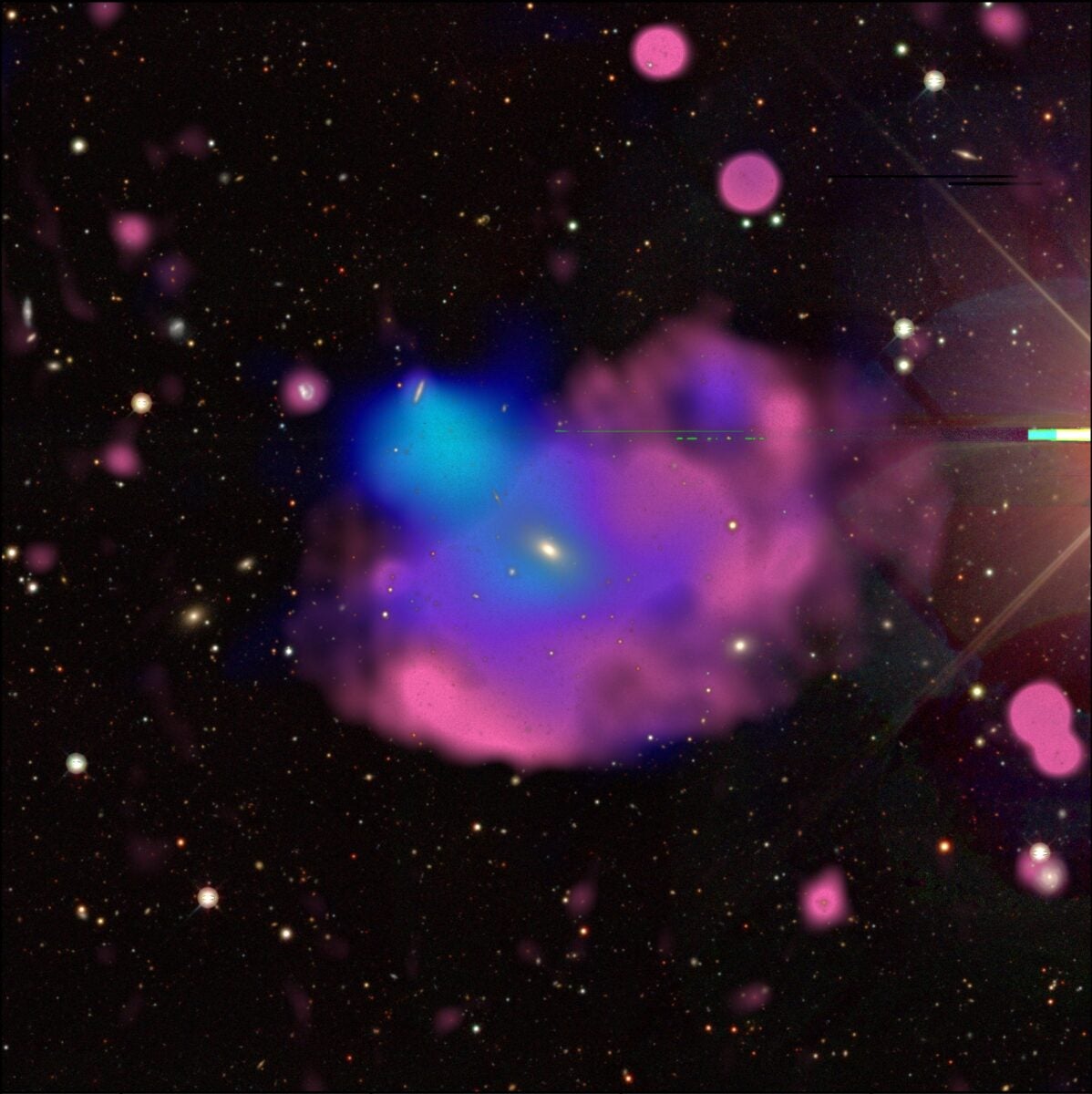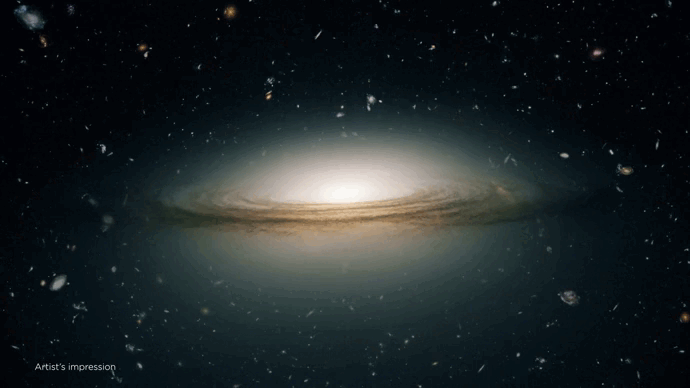
In 2020 when astronomers using the Australian Square Kilometer Array Pathfinder (ASKAP) discovered ghostly circles of radio emissions in the sky that were so gigantic, they surpassed our Milky Way’s size tenfold. And so far, no known cosmic phenomenon could explain how they came to existence and what they even are.
The supremely inflated profiles of the gigantic circles didn’t agree with circular features otherwise common in radio images, such as the shell of material shed by a dying star or a face-on view of a dusty protoplanetary disk — they’re unlike anything mentioned in previous studies. And because the handful of bizarre objects could be seen by more than one telescope at different times and wavelengths, astronomers ruled out the possibility that they were banal artifacts present in telescopic raw data. Due to the mysterious origin of the enormous space rings, and brevity, the discovery team dubbed them as “Odd Radio Circles,” or ORCs.
Four more such bizarre radio circles recently turned up in newer ASKAP data and in images gathered by South Africa’s MeerKAT radio telescope, including an intriguing ORC with a double-lobed feature. With such a limited dataset of ORCs, prying their origins is difficult for astrophysicists who are struggling to understand the physical processes that could possibly produce such massive rings of emission. “I would say we are really at the beginning of understanding these kinds of systems,” says Xiaoyuan Zhang of the Max Planck Institute for Extraterrestrial Physics (MPE) in Germany.
A lucky four-leaf clover

In a new study, Zhang and his colleagues propose the origin for one such radio circle dubbed the Cloverleaf, which resides about 600 million light-years from Earth and spans over a hundred kiloparsecs (the Milky Way is about 30 kpc across). Based on observations gathered by the European Space Agency’s XMM-Newton telescope, the researchers say Cloverleaf may have been created by two groups of galaxies that gravitated toward each other and are in the midst of a messy merger. The galaxy group seems to host at least a dozen galaxies as old as the universe that are in varying levels of disfiguration, although just how many are in each group remains unclear. It’s possible that the merger created shock waves that accelerated fossil cosmic ray particles within the galaxies, which would have created the observed radio emission, Zhang and his team reported in a paper published late April in the journal Astronomy and Astrophysics Letters.
If the findings pan out, astronomers will have gotten a step closer to figuring out how ORCs are birthed and balloon to their light-years-long sizes. “The fact that we are one of the first groups to suggest some origin, of course we are very happy about that,” says study lead author Esra Bulbul of MPE. “We’re excited by the prospect of what these observations really mean, but there are still lots of open questions that we would like to answer.”
For instance, galaxy mergers frequently occur without any associated ORCs recorded, so it’s important to pin down what creates the galaxy groups that produce Cloverleaf unique, says Bulbul. Given there are only a handful of known ORCs, any explanation for their presence must also explain their rarity in general. “That’s the question we’re trying to answer,” she says.
Persistence and a sprinkle of luck
Bulbul and her team poured over data from the German-Russian Extended Roentgen Survey with an Imaging Telescope Array (eROSITA) space telescope, which collected X-ray radiation from the entire sky from 2019 until February 2022 — observations were paused to protest Russia’s invasion of Ukraine.
Based on just seven minutes of observations, the team spotted “something, but it wasn’t really a detection,” says Bulbul. To learn more, the researchers gathered a little more than five hours of data from XMM-Newton last year. This allowed the team to probe large swaths of the sky much deeper than eROSITA ever could.
“As soon as I got the observations, I sent them to Xiaoyuan,” recalls Bulbul. “The next morning, I asked him, ‘So, did you have a look at it?’ To my surprise, he said, ‘Yes, it’s a detection!’”
The XMM-Newton data basically proved that as much as 700 billion solar masses worth of hot gas wafted among the dozen galaxies, explains Zhang. The gas reaches temperatures around 15 million degrees Fahrenheit (8 million degrees Celsius), offering the kind of environment where cosmic rays are accelerated.
“We really got lucky,” Zhang said in a NASA statement. “It turns out the eROSITA sources couldn’t have been from the Cloverleaf, but it was compelling enough to get us to take a closer look.”
The source of the energetic cosmic rays themselves is currently unknown. It’s possible that they were created when supermassive black holes lurking at galaxy centers underwent bursts of extreme activity, according to Kim Weaver, the project scientist for XMM-Newton at NASA’s Goddard Space Flight Center in Maryland, who was not involved in the study. Perhaps “relic electrons from that ancient activity were reaccelerated by this merging event,” she said in the NASA statement.
What defines an ORC?
Not everyone is convinced, however, that the Cloverleaf checks off all boxes that conventionally define an ORC. Ray Norris, an astrophysicist at the Western Sydney University in Australia who spearheaded the discovery of the first ORCs using ASKAP in 2020, says Cloverleaf lacks prominent tell-tale brightening at the edges of the radio emission normally associated with the celestial oddballs. “They have found a diffuse cloud of radio emission with some structure in it,” says Norris. “Interesting, but not an ORC.”
He noted astronomers are starting to see many structures like the Cloverleaf in galaxy groups, not all of which represent an ORC. A team led by Norris in 2022 narrowed the origins of ORCs to three scenarios: They could be due to leftovers of huge explosions at galaxy centers, such as those sparked by merging black holes, or energetic particles pumped by jets from black holes, or the products of shock waves emerged from the burst of a star’s birth in a galaxy. “We need better data — and to get rid of the wannabe ORCs! — to distinguish between these models,” says Norris.
Deeper observations in both radio and X-ray wavelengths, which can reveal nuanced structures of the gases wafting in the ORCs, could shed more light on the origin of Cloverleaf and other cataloged ORCs, says Zhang.
“We stand to learn a lot from more thorough observations because these interactions take in all kinds of science,” Weaver said in the NASA statement. “You’ve pretty much got everything that we deal with in the cosmos put together in this little package — it’s like a mini universe.”









